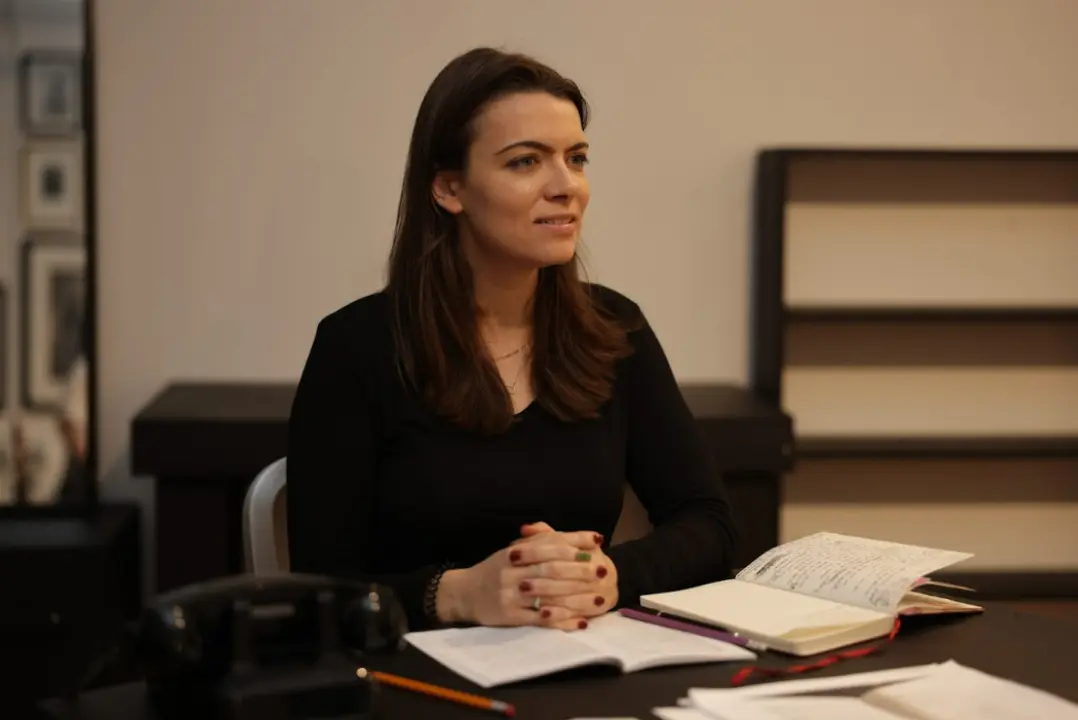APPLY FOR ADMISSION
FIRST YEAR MEISNER ACTING PROGRAM

Begins January 7th, 2025

Call To Schedule an Interview
(917) 794-3878
7 Key Steps on How to Write a One-Man Show
Writing a one-man show is one of the most exciting challenges an actor can take on. So, how to write a one-man show that captivates an audience?
As with anything creative, it must start with an idea, a compelling concept that involves personal storytelling, and a clear structure that lets your idea come to fruition.
Maggie Flanigan Studio’s New York City acting classes provide actors with the tools to create and develop compelling solo performances, teaching them to discover and then use their artistic voice to create something compelling and interesting to watch.
Excited to get started? Let’s break down the steps that will turn your idea into a one-man show that captivates from start to finish.
Key Takeaways
- Let your passion fuel your solo show—personal stories can create the most powerful performances.
- Craft a dynamic structure that keeps your audience hooked from start to finish.
- Refine, rehearse, and embrace feedback to transform your solo show into a captivating experience for the audience.
Step 1: Choose a Subject You’re Passionate About
To write a one-person show, start with a subject that ignites you. Ask yourself: What’s a story or idea you’re willing to live with, write about, and perform over and over again? Here are a few ways to find that subject:
Personal stories: As I tell my students all the time, art is personal, it illuminates the human condition in all of its aspects. Look into your own life experiences, your relationships, the circumstances that have shaped you, and mold them imaginatively into a compelling narrative.
What moments stand out? These could be decisions that changed your life, encounters that altered your perspective, or situations that forced you to grow.
Personal stories resonate because they’re real, and they allow the audience to connect with your humanity. These are the life moments that make for powerful material.
Historical inspiration: If personal stories don’t speak to you, history is another rich source of inspiration. Historical figures and events can bring depth and meaning to a solo performance. It is important that this is a subject you are passionate about, something you have real feelings towards.
This requires intellectual curiosity about the world. If you read voraciously and watch films and interesting documentaries, you can come across someone who’s life story blows you away. Stay open to inspiration.
Douglas Taurel’s “The American Soldier” is a perfect example of drawing inspiration from the past, as he used letters from veterans to craft a compelling narrative.
Big ideas or fictional characters: Your show can explore a theme that you care about, expressed through a character you create. This could be a one-person story or one that plays with multiple perspectives, like a single actor switching between two characters on stage.
The key is to choose an idea that excites and challenges you, giving you endless possibilities to explore.
Step 2: Free Write and Gather Material
Once you’ve chosen your subject, it’s time to let the words flow. This stage isn’t about perfection. It’s about freedom.
Focus on writing anything that comes to mind related to your story, play, or character. The goal is to get your ideas on paper and start building the foundation for your one-person show.
Free write daily: Set aside 15–20 minutes a day to write, even if it feels scattered at first. The more you write, the clearer your vision will become.
This is a tough challenge, because some days you aren’t going to feel like writing. You might end up sitting and staring at a blank page for 20 minutes. That’s ok. Just be consistent in dedicating this time every day. Build it into your calendar, and establish the discipline to be consistent.
The first draft isn’t going to be polished, and will most certainly look nothing like the finished product—it’s just you and your thoughts, so let them spill out. If a line of dialogue from your past or an odd conversation comes into your head that may not make any sense to you, write it out. At this stage, just get ideas on the page.
Explore moments: Think of specific moments that are key to your story. What does your character experience in this world? What moments shift them? Whether it’s an emotional breakthrough or a quiet realization, these are the anchors of your script. These moments will ultimately be strung together and form the journey of your show.
Use resources: Need inspiration? Explore YouTube, read articles, read memoirs, or dive into your personal memories. You can also draw from other performances, off-Broadway productions, or solo shows you’ve seen.
Even if it’s something as simple as remembering a best friend who influenced your life, these reflections can spark powerful ideas that may be completely unrelated.
Focus on the story: It’s important not to limit yourself too soon. Explore different characters, perspectives, or ideas.
Are there multiple characters you want to include, even if they only exist through dialogue with your lead? Don’t be afraid to write scenes where your character interacts with people who aren’t physically there.
Step 3: Create and Develop Your Characters
Even though you’re performing a one-person show, developing multiple characters adds depth and variety and keeps the audience engaged. With just you on stage, your ability to create distinct characters is key to making the performance dynamic.
Start with one character: Begin by fleshing out a single character. How do they speak? How do they move? How do they exist in the world?
Imagine their background and how they fit into the larger story. For example, one character could be quiet and introspective, while another is bold and expressive. Opposites are also good to explore when you are creating characters.
Use contrast: To keep things interesting, create clear differences between your characters. Contrast their personalities, energy levels, and even the way they interact with the world.
The challenge will become how to shift between them easily, how to carve out unique, fully realized human beings.
Play with voices and movements: Use different vocal tones, accents, and physical gestures to make each character distinct. A change in posture or a unique movement can instantly signal to the audience that you’ve switched from one character to another.
At my studio I encourage students to work with animal essence, and also take aspects of the people in your life that have interesting or vivid mannerisms. You need to be a passionate observer of human behavior if you want to act.
Include unseen characters: Not all characters need to be on stage. You can develop multiple characters who only exist through dialogue or reaction. This adds an extra layer of complexity and intrigue to your solo show.
Step 4: Organize Your Ideas into a Structure
Now that you’ve gathered your material and developed your characters, it’s time to give your solo show structure. Without a clear structure, your audience could get lost, so it’s crucial to map out your ideas in a way that guides them through your performance.
What is the journey of the piece, the journey for your main characters? It’s important to establish a clear beginning, middle and end.
Print and arrange: Start by printing out all your notes, lines, and ideas from your first draft. Lay everything out in front of you so you can visually see the pieces of your play. This helps you find the natural order of your story and spot any gaps or weak points that need strengthening.
Find transitions: Look for smooth transitions between moments or characters. How does one scene lead to the next? Are there emotional shifts or moments where your actor needs to change perspective or tone?
Ensure that the flow between these transitions feels natural, even if you’re shifting from one person to another.
Create a bullet point outline: Organize your solo show into a simple outline or bullet points. This helps map out the entire script and ensures it has a clear beginning, middle, and end.
A strong structure guides the audience and helps your performance build momentum. Identify key moments where the energy shifts or where your character’s journey takes a turn. Each scene should push the story forward, so make sure nothing feels stagnant or unnecessary.
Step 5: Rehearse and Refine Your Performance
With your script in place, the next step is rehearsal. In a solo show, every word, line, and moment relies on your performance—after all, it’s just you on the stage. As both the actor and the creator, it’s essential to make your words come alive and connect with the audience.
I recommend finding someone to direct your piece, someone who has experience staging theater. You are going to want an outside eye to not only help shape your acting, but provide the eyes and ears to the material.
Rehearse in a proper space: Find a rehearsal room that has the space you need to be able to block out your show. Work from scene to scene or beat to beat, and try to get the spine of the piece in place. Then start working on the more detailed moment to moment work.
When you practice this way, you’ll also become more comfortable with pacing and the emotional transitions of the show.
Embody the characters: Even though you’re performing solo, imagine interacting with the unseen characters in your story.
Whether it’s an American soldier in a conversation or a close friend you’re remembering, your ability to bring these interactions to life will add depth to your performance. Audiences should feel like they’re experiencing these moments with you for the first time.
Focus on timing: Pay attention to the rhythm of your show. Each line needs to land with the right energy, and sense of truth. Fine-tuning your timing ensures every moment connects with the audience.
Refine emotional beats: As you rehearse, identify the key emotional beats in your show. These are the moments that hold the most weight—where the story shifts or where your character experiences a significant change. Practice these beats so they feel genuine and impactful.
Make it fun: Rehearsing can be intense, but don’t forget to have fun. This is your play, your creation. Explore different interpretations of your characters and experiment with how each scene unfolds. The more you enjoy the process, the more your performance will shine.
Stay flexible: As you rehearse, remember that this is a living, breathing process. Be open to changes and expect some lines or scenes to evolve as you perform. This flexibility will make your show more dynamic and enjoyable for both you and your audience.
Step 6: Work with a Director or Join a Workshop
Even though a solo show is all about your personal story and performance, having a fresh perspective can make all the difference.
Collaborating with a skilled director or joining a workshop is a powerful way to enhance your work so you can go beyond what you thought possible.
Get expert feedback: Working with a director who understands the nuances of solo performers can push you to explore new emotional depths and sharpen your overall performance.
A director will help refine your timing, guide your transitions, and make sure each moment resonates with your audience. They can spot areas for improvement you might overlook on your own and help you shape your work into something extraordinary.
Join workshops designed for growth: Joining a workshop gives you the chance to perform in front of others and gather crucial feedback.
These workshops allow you to test your material, experiment with pacing, and receive practical, honest input from both peers and seasoned professionals. It’s the perfect place to try out new ideas and strengthen your performance while also connecting with a community of other actors working on similar projects.
Shape your final piece: Performing your material for an audience, even in a workshop setting, helps you identify what works and what doesn’t. This feedback is invaluable in helping you fine-tune your script.
Letting go of the fear of being seen and allowing others to critique your work will push you toward a final product that feels polished and fully realized.
Step 7: Refine Your Final Draft
Refining your final draft is about getting your performance to its full potential. Stay open to small changes that can elevate the piece, and remember that feedback will help you create something truly powerful.
This final step transforms your vision into a polished, stage-ready performance.
Trim the excess: Go through your script and cut out any sections that don’t push the story forward or feel redundant. Every word should serve a purpose. Keep the story tight and focused, so the audience remains engaged throughout.
Polish your lines: As you refine, focus on how your lines sound. Does the dialogue flow naturally? Read it out loud again, paying attention to how it feels to speak the words.
The more conversational and real it sounds, the easier it will be to connect with your audience. This is where you’ll make small tweaks to ensure everything feels smooth and purposeful.
Master transitions: Make sure each shift feels seamless and natural. As you move between moments of vulnerability and humor or switch between different characters, the audience should be able to follow easily without feeling disoriented.
Adjust your pacing to ensure each moment has the space it deserves.
Test pacing and emotional beats: Ensure your pacing feels right. Some moments may need to slow down for impact, while others require more energy. Watch how your audience reacts—if an emotional beat isn’t landing, refine the lines or delivery.
Take Your Solo Performance to the Next Level
The Maggie Flanigan Studio understands that creating your own play, especially a powerful solo show, requires more than just great acting—it’s about revealing emotional truth
Our Meisner-based Professional Actor Training Program gives actors the tools they need to perform with depth and authenticity. With classes like Movement, Voice & Speech, and Script Analysis, we will provide you with the skill-set needed to begin creating and acting in your own material.
Our expert faculty will guide you through every aspect of your creative process, from creating organic, vivid behavior, to acting with emotional clarity in order to ensure each moment on stage feels genuine. You might be working on a personal story or a historical narrative —our training helps you connect deeply with your audience and improve your performance.
The Maggie Flanigan Studio provides the perfect setting to bring your passion to life. From your first solo show to preparing for an off-Broadway debut, we’re here to support you every step of the way. Let’s work together—call today to push your solo performance to new heights.
Summary
Creating and performing a solo show is a bold and rewarding process. With a clear script, a strong connection to your material, and the right acting tools, you can craft a performance that leaves a lasting impact on your audience.
Every moment you spend refining your story and developing your characters brings you closer to a powerful, stage-ready production.
The Maggie Flanigan Studio guides actors through every step, from the first draft to the final performance. Your solo show is your chance to share your unique voice with the world—trust the process, stay inspired, and create something unforgettable.
Frequently Asked Questions
How to structure a one-person show?
A one-person show should follow a clear, three-act structure: beginning, middle, and end.
Start by introducing the central character and conflict, then build toward a climax where the character faces a major challenge or realization. Finally, resolve the conflict in a way that brings emotional closure to the story.
How to write a one-man show script?
When writing a one-man show script, focus on creating a compelling character and a strong narrative arc. Start with a subject you’re passionate about and free write to gather material.
Once you have your ideas, organize them into a structured script with clear dialogue, emotional beats, and moments of action. Be sure to keep the dialogue natural so it allows the audience to connect with your character’s journey.
What makes a great one-man show?
A great one-man show captivates the audience with a mix of emotional depth, strong storytelling, and dynamic character development. The performer’s ability to create distinct, engaging characters and deliver an authentic, heartfelt performance is key.
A well-written script with a clear message, combined with seamless transitions and pacing, helps the performance connect with the audience long after the show ends.
Recent Post
STUDENT TESTIMONIALS
“I was placed in the intense reigns of Charlie Sandlan. I became a better artist, actor, friend, sibling and daughter because of the studio. Even now, I crave the studio every day. What I learned is present in my work every day. I truly believe in everything they stand for.”

“Maggie taught me that I could control my work, my acting, and to throw all of the bullshit out that I had in my head about ‘what I should be doing’ and to just listen and respond honestly, in the moment. She gave me a craft. She is, quite simply put, THE BEST.”

“Maggie Flanigan taught me the true meaning of artistry, passion, and professionalism. I am certain that I continue to work as an actress because of my training with Maggie. At every audition and every performance, her guiding voice is with me. It is a gift beyond measure.”

“Maggie Flanigan is uncompromising, her instincts as a teacher are razor sharp. She doesn’t miss a beat”

“Maggie Flanigan has been one of the most important people in my artistic life. I want to work with Maggie trained actors. As an actor myself, she is my first source. I do not say this lightly, if you are serious about acting, and willing to work very hard, then go to Maggie.”

“Maggie helped me find my sense of truth, an actors greatest asset. Maggie is an expert at instilling that vital ingredient, which allows an actor’s potential to become limitless. My work will forever be rooted in the clarity and honesty she helped me develop.”

“After working for ten years, I did the 2 year program, and now feel that I have the tools I need to become the actor I’ve always dreamed of being. Maggie Flanigan instilled in me a clear sense of truth and a standard of perfection. I am a better actor because of this studio.”

“As an actor, the core of what you have to rely on is your sense of truth and humanity. Maggie allowed me to discover and embrace mine. Trusting my sense of humanity and truth has given me the ability to take risks in my work and my career decisions.”

“Maggie Flanigan has the unique ability to get an actor to the essence of what is true in a moment. She creates a safe and caring environment in which to work.”

“Maggie Flanigan introduced me to my own spirit and my own sense of Truth. Her passion for teaching and ability to communicate are rare gifts to any actor looking for a technique to set his or her talent free. Maggie’s voice has been the one constant guide in my career.”






